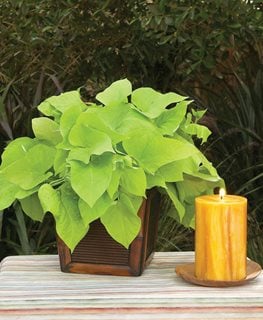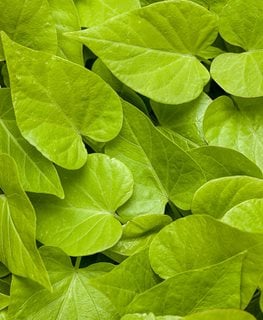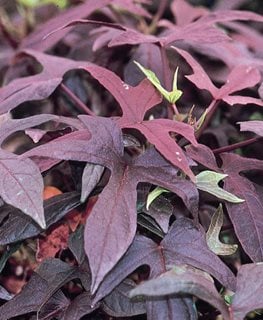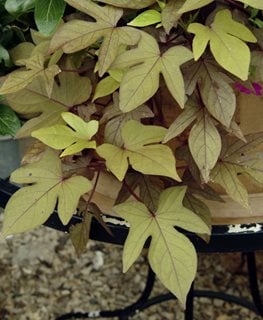GROWING SWEET POTATO VINE
Add an exotic touch to your garden with these easy, quick-growing annuals
Sweet Caroline Bewitched Green with Envy™ sweet potato vine and Rockin® Deep Purple salvia. Photo by: Proven Winners
One of the easiest ways to create multi-seasonal interest in the garden is to use plants with interesting foliage. Sweet potato vine (Ipomoea batatas), named for its edible cousin, is an ornamental warm-season annual grown for its attractive leaves and vining habit. The foliage lends a tropical feel to the garden and comes in a range of colors and varying forms.
The vigorous vines can reach up to 10 feet long and are most often used as a trailing accent in containers. They can also be used as a ground cover or grown up a trellis. Newer varieties have been bred for disease resistance, a wider range of color and leaf shape, as well as compact sizes that are suitable for containers and small spaces.
On this page: The Basics | Planting | Care | Choosing the Right Sweet Potato Vine | Pictures | Landscaping Tips
- THE BASICS
- PLANTING
- CARE AND MAINTENANCE
- HOW TO CHOOSE THE RIGHT SWEET POTATO VINE
- VARIETIES
- LANDSCAPING TIPS
- BONUS DIY TERRA COTTA PLANTER WALL
THE BASICS
Zones:
Annual, perennial in Zone 11
Height/Spread:
6 to 16 inches tall, 3 to 6 feet wide, up to 10 feet long
Exposure:
Best with at least 6 hours of full sun, they can take some shade.
Bloom time:
Flowers are insignificant, with little to no bloom during summer.
Color and characteristics:
Plants have a mounding, trailing habit, with foliage in shades of chartreuse, gold, bronze, brown, red, purple and nearly black. Some have variegation or mottling. Leaves are heart-shaped, lacy or deeply lobed, similar to maple, ivy, or philodendron. Color is richest in full sun. Lavender or pink tubular flowers appear primarily on older varieties, though rarely.
Toxicity:
Tubers are edible but not meant for consumption. Leaves contain the same principal ingredient as LSD, and can be highly toxic to pets if ingested. Call your veterinarian or poison control center immediately if your pet exhibits symptoms of vomiting, diarrhea, or hallucinations.
PLANTING TIPS
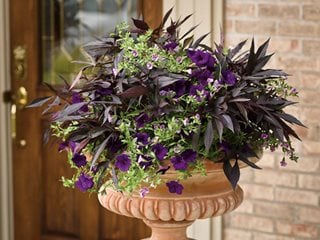
Illusion® Midnight Lace sweet potato vine combined with Supertunia® Royal Velvet® and Superbells® Miss Lilac for a ‘Truly Elegant’ container. Photo by: Proven Winners.
When to plant:
Plant in spring or early summer when all danger of frost is past. Nighttime temperatures should be above 40 to 45 degrees to avoid cold damage. Minimum nighttime temperatures below 55 degrees can delay growth.
Where to plant:
Choose a sunny site with rich, well-draining soil. They prefer hot, humid conditions similar to their native habitat and may fail to thrive in dry desert climates. In cooler regions, boost performance by planting in a warm location such as a south-facing wall or heat-absorbing patio.
How to plant:
Carefully remove the plant from the container, being careful not to damage the delicate stem. Gently loosen the roots if potbound. Dig a planting hole twice the diameter and depth of the container and place the plant at the same level it was in the container. Gently tamp down soil around the base and water well. Spacing will vary, from 6 to 12 inches for smaller varieties and up to 2 feet for larger specimens.
CARE AND MAINTENANCE
Pruning and deadheading:
In ideal conditions, they can quickly outgrow a space. Lightly prune or shape as needed.
Soil:
For containers, plant in a high quality all-purpose potting soil. If using as a ground cover in a garden bed, amend soil with rich compost and make sure it is well-draining.
Amendments & fertilizer:
Apply a slow-release fertilizer at the time of planting, or use a water-soluble fertilizer monthly.
Watering:
Keep plants moderately moist, watering once a week, or more during hot spells. Don’t overwater or allow plants to dry out.
Diseases and pests:
When kept healthy, plants are resistant to most pests and diseases. Possible insect problems include sweet potato looper, whitefly, aphids, thrips, slugs, flea beetles, and weevils. Overwatering and poor drainage can cause fungal problems such as fusarium wilt, root rot or tuber rot.
Overwintering:
Sweet potato vines can be overwintered indoors from tubers or cuttings. Plants can also be brought indoors and treated as houseplants. Store dormant tubers in a cool, dry place and replant in spring. Take cuttings several weeks before your average first frost date and place in water. Once roots have formed, cuttings can either be left in water until spring, or potted up.
Deer resistance:
Plants are generally considered resistant to deer grazing, though some gardeners have experienced damage.
HOW TO CHOOSE THE RIGHT SWEET POTATO VINE
With so many varieties to choose from, here are some tips to consider:
For bedding displays and borders:
Choose mounding and semi-compact varieties for the edge of a border, or larger trailing types that will quickly fill in larger areas.
For containers, hanging baskets and window boxes:
Select smaller, more compact varieties that won’t overwhelm other adjacent plants.
For slopes and walls:
Larger sprawling varieties will quickly cover large areas and drape down a slope or wall for a dramatic effect.
VARIETIES
Featured in: Garden Design's Top 10 Garden Trends for 2022 ("Designing with Dark Foliage")
LANDSCAPING TIPS
There are many ways to incorporate this semi-tropical accent into any landscape. Here’s how:
- Plant a larger variety along the top of a rock wall and allow it to spread vertically along the top and spill over the edge.
- Mass bigger varieties along a barren slope for a quick burst of color.
- Place a decorative container in your entryway or on a deck or patio for a compelling focal point.
- Train a longer variety up a trellis or arbor and combine with firecracker vine, scarlet runner bean, morning glory, or other quick-growing annual flowering vines.
- Plant a sunny window box with trailing varieties that will spill over the edge. Combine with upright, heat-loving annuals such as coleus or dracaena.
- Plant sprawling varieties along the front of a mixed border for easy pops of summertime color.
- Combine with other warm-season annuals in a hanging basket and place on a shepherd’s hook that can be moved around the yard when you need color in a particular area.
- Mix with a wide array of warm-season annuals, including coleus, petunia, calibrachoa, cordyline, ‘Bonfire’ begonia, lantana, ‘Profusion’ zinnias, cuphea and purple fountain grass.
BONUS: DIY TERRA COTTA PLANTER WALL
Maximize garden space and create a living backdrop. The plant list for this project includes 'Sweet Caroline Sweetheart Lime' sweet potato vine, along with a mix of Superbells® calibrachoa, Supertunia® petunias, African daisies, purslane, verbena, and other flowering annuals. Check out this time lapse video to learn how to build one for your garden.
RELATED:
How to Create a Container Planting
Annual Flowers to Consider for Your Garden
Modern Plants for a Bold and Beautiful Garden


